Enhanced cardiac Akt/protein kinase B signaling contributes to pathological cardiac hypertrophy in part by impairing mitochondrial function via transcriptional repression of mitochondrion-targeted nuclear genes
- PMID: 25535334
- PMCID: PMC4323486
- DOI: 10.1128/MCB.01109-14
Enhanced cardiac Akt/protein kinase B signaling contributes to pathological cardiac hypertrophy in part by impairing mitochondrial function via transcriptional repression of mitochondrion-targeted nuclear genes
Abstract
Sustained Akt activation induces cardiac hypertrophy (LVH), which may lead to heart failure. This study tested the hypothesis that Akt activation contributes to mitochondrial dysfunction in pathological LVH. Akt activation induced LVH and progressive repression of mitochondrial fatty acid oxidation (FAO) pathways. Preventing LVH by inhibiting mTOR failed to prevent the decline in mitochondrial function, but glucose utilization was maintained. Akt activation represses expression of mitochondrial regulatory, FAO, and oxidative phosphorylation genes in vivo that correlate with the duration of Akt activation in part by reducing FOXO-mediated transcriptional activation of mitochondrion-targeted nuclear genes in concert with reduced signaling via peroxisome proliferator-activated receptor α (PPARα)/PGC-1α and other transcriptional regulators. In cultured myocytes, Akt activation disrupted mitochondrial bioenergetics, which could be partially reversed by maintaining nuclear FOXO but not by increasing PGC-1α. Thus, although short-term Akt activation may be cardioprotective during ischemia by reducing mitochondrial metabolism and increasing glycolysis, long-term Akt activation in the adult heart contributes to pathological LVH in part by reducing mitochondrial oxidative capacity.
Copyright © 2015, American Society for Microbiology. All Rights Reserved.
Figures


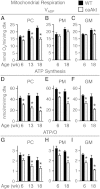
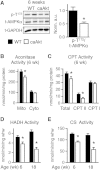
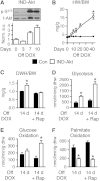



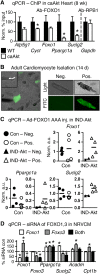

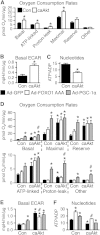
Similar articles
-
Estrogen-related receptor alpha directs peroxisome proliferator-activated receptor alpha signaling in the transcriptional control of energy metabolism in cardiac and skeletal muscle.Mol Cell Biol. 2004 Oct;24(20):9079-91. doi: 10.1128/MCB.24.20.9079-9091.2004. Mol Cell Biol. 2004. PMID: 15456881 Free PMC article.
-
High-fat feeding in cardiomyocyte-restricted PPARdelta knockout mice leads to cardiac overexpression of lipid metabolic genes but fails to rescue cardiac phenotypes.J Mol Cell Cardiol. 2009 Oct;47(4):536-43. doi: 10.1016/j.yjmcc.2009.07.001. Epub 2009 Jul 9. J Mol Cell Cardiol. 2009. PMID: 19595695 Free PMC article.
-
Regulating cardiac energy metabolism and bioenergetics by targeting the DNA damage repair protein BRCA1.J Thorac Cardiovasc Surg. 2013 Sep;146(3):702-9. doi: 10.1016/j.jtcvs.2012.12.046. Epub 2013 Jan 12. J Thorac Cardiovasc Surg. 2013. PMID: 23317938
-
Transcriptional activation of energy metabolic switches in the developing and hypertrophied heart.Clin Exp Pharmacol Physiol. 2002 Apr;29(4):339-45. doi: 10.1046/j.1440-1681.2002.03655.x. Clin Exp Pharmacol Physiol. 2002. PMID: 11985547 Review.
-
PPAR signaling in the control of cardiac energy metabolism.Trends Cardiovasc Med. 2000 Aug;10(6):238-45. doi: 10.1016/s1050-1738(00)00077-3. Trends Cardiovasc Med. 2000. PMID: 11282301 Review.
Cited by
-
Post-translational modifications of the cardiac proteome in diabetes and heart failure.Proteomics Clin Appl. 2016 Jan;10(1):25-38. doi: 10.1002/prca.201500052. Epub 2015 Sep 14. Proteomics Clin Appl. 2016. PMID: 26140508 Free PMC article. Review.
-
Increased Glucose Availability Attenuates Myocardial Ketone Body Utilization.J Am Heart Assoc. 2020 Aug 4;9(15):e013039. doi: 10.1161/JAHA.119.013039. Epub 2020 Jul 30. J Am Heart Assoc. 2020. PMID: 32750298 Free PMC article.
-
Animal Models of Dysregulated Cardiac Metabolism.Circ Res. 2022 Jun 10;130(12):1965-1993. doi: 10.1161/CIRCRESAHA.122.320334. Epub 2022 Jun 9. Circ Res. 2022. PMID: 35679363 Free PMC article. Review.
-
Whole Cell Cross-Linking to Discover Host-Microbe Protein Cognate Receptor/Ligand Pairs.Front Microbiol. 2018 Jul 19;9:1585. doi: 10.3389/fmicb.2018.01585. eCollection 2018. Front Microbiol. 2018. PMID: 30072965 Free PMC article.
-
Cancer-A Major Cardiac Comorbidity With Implications on Cardiovascular Metabolism.Front Physiol. 2021 Nov 26;12:729713. doi: 10.3389/fphys.2021.729713. eCollection 2021. Front Physiol. 2021. PMID: 34899373 Free PMC article. Review.
References
-
- Riehle C, Wende AR, Zaha VG, Pires KM, Wayment B, Olsen C, Bugger H, Buchanan J, Wang X, Moreira AB, Doenst T, Medina-Gomez G, Litwin SE, Lelliott CJ, Vidal-Puig A, Abel ED. 2011. PGC-1β deficiency accelerates the transition to heart failure in pressure overload hypertrophy. Circ Res 109:783–793. doi:10.1161/CIRCRESAHA.111.243964. - DOI - PMC - PubMed
Publication types
MeSH terms
Substances
Grants and funding
LinkOut - more resources
Full Text Sources
Other Literature Sources
Molecular Biology Databases
Miscellaneous
